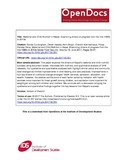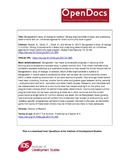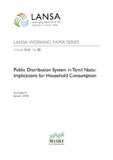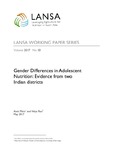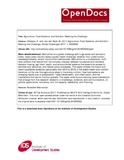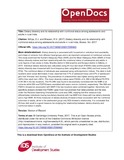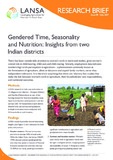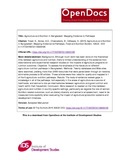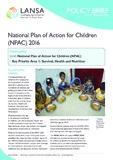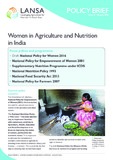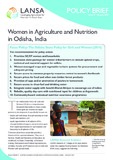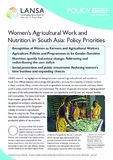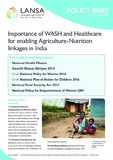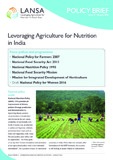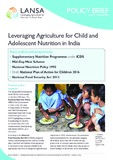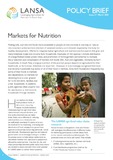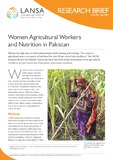Leveraging Agriculture for Nutrition in South Asia (LANSA): Recent submissions
Now showing items 41-60 of 98
-
Maternal and Child Nutrition in Nepal: Examining drivers of progress from the mid-1990s to 2010s
(2017)This paper explores the drivers of Nepal's maternal and child nutrition success using document review, interviews with mothers, and quantitative analysis of DHS datasets. Our qualitative and quantitative analyses both ... -
Community-level perceptions of drivers of change in nutrition: Evidence from South Asia and sub-Saharan Africa
(Elsevier, 2017)Changes in the immediate, underlying and basic determinants of nutritional status at the community-and household-level are a logical and empirical prerequisite to reducing high levels of undernutrition in high burden ... -
Bangladesh’s Story of Change in Nutrition: Strong Improvements in Basic and Underlying Determinants with an Unfinished Agenda for Direct Community Level Support
(Elsevier, 2017)Bangladesh has made considerable progress in reducing child stunting and is lauded as a success story in global nutrition fora. This mixed-methods study considers available statistical and qualitative evidence to help ... -
Public Distribution System in Tamil Nadu: Implications for Household Consumption
(Leveraging Agriculture for Nutrition in South Asia (LANSA), 2018)Food and nutrition insecurity is a reality for a large number of people in India. Social safety nets to ensure food security of the poor and vulnerable become important in such a scenario. The Public Distribution System ... -
Gender Differences in Adolescent Nutrition: Evidence from two Indian districts
(Leveraging Agriculture for Nutrition in South Asia (LANSA), 2017-05)India is going through a silent crisis as millions of adolescents and adults, both male and female, across the country and over generations face the burden of undernutrition. India’s score in the Global Hunger Index (GHI) ... -
Agriculture, Food Systems, and Nutrition: Meeting the Challenge
(WILEY-VCH Verlag GmbH & Co, 2017)Malnutrition is a global challenge with huge social and economic costs; nearly every country faces a public health challenge, whether from undernutrition, overweight/obesity, and/or micronutrient deficiencies. Malnutrition ... -
Establishing Integrated Agriculture-Nutrition Programmes to Diversify Household Food and Diets in Rural India
(Springer, 2017)Agriculture is the predominant livelihood for 70 % of the population living in rural India, and food expenses occupy a major proportion of their household budget. Rural household diets suggest that agricultural growth has ... -
Dietary Diversity and Its Relationship with Nutritional Status among Adolescents and Adults in Rural India
(Cambridge University Press, 2017)Dietary diversity is associated with household or individual food availability and intake of nutrients from different food groups and is an important component of nutritional outcome. This study examined the Nutrient ... -
Gendered Time, Seasonality and Nutrition: Insights from two Indian districts
(Leveraging Agriculture for Nutrition in South Asia, 2017)There has been considerable attention to women’s work in nutritional studies, given women’s central role in child-bearing, child-care and child-rearing. Similarly, employment data indicates women’s high work-participation ... -
Agriculture and Nutrition in Bangladesh: Mapping Evidence to Pathways
(SAGE, 2015)Background: Although much work has been done on the theoretical links between agriculture and nutrition, there is limited understanding of the evidence from observational and experimental research studies on the impacts ... -
Explaining Cross-State Disparities in Child Nutrition in Rural India
(Elsevier, 2015)What drives the large disparities in height-for-age distributions among Indian states - variation in observed nutrition-related endowments, such as wealth or maternal education, or differential strengths of relationships ... -
National Plan of Action for Children (NPAC) 2016
(Leveraging Agriculture for Nutrition in South Asia, 2016)The National Policy for Children 2013 adopted by the Government of India in April 2013, adheres to the Constitutional mandate and guiding principles of the United Nations Convention on the Rights of the Child (UNCRC). It ... -
Women in Agriculture and Nutrition in India
(Leveraging Agriculture for Nutrition in South Asia, 2016)Policy debates around agriculture and nutrition and the crucial role of women needs to be informed by evidence that research programmes like LANSA generate. The available evidence recommends the recognition of women’s roles ... -
Women in Agriculture and Nutrition in Odisha, India
(Leveraging Agriculture for Nutrition in South Asia, 2017-08)The Odisha State Policy for Girls and Women (2014) is a comprehensive document that seeks to create a state where girls and women are equal partners in development. It specifically focuses on: health and well-being, through ... -
Women’s Agricultural Work and Nutrition in South Asia: Policy Priorities
(Leveraging Agriculture for Nutrition in South Asia, 2017)ANSA research has highlighted the linkage between women’s agricultural work and nutrition in South Asia. Official statistics acknowledge that agriculture accounts for a majority of women workers in these countries. Many ... -
Importance of WASH and Healthcare for enabling Agriculture-Nutrition linkages in India
(Leveraging Agriculture for Nutrition in South Asia, 2016)State and district level studies linking child undernutrition to agricultural prosperity and provisioning of public services highlight the importance of public health provisioning such as sanitation, vaccination and ... -
Leveraging Agriculture for Nutrition in India
(Leveraging Agriculture for Nutrition in South Asia, 2016)A state level analysis of agriculture and child nutrition linkages in India exploring the associations between agricultural prosperity and rural child undernutrition after controlling for access to sanitation and safe ... -
Leveraging Agriculture for Child and Adolescent Nutrition in India
(Leveraging Agriculture for Nutrition in South Asia, 2016)Ensuring access and safety of food to meet the nutritional requirements of proteins, calories and micronutrients in infancy and childhood from six months of age needs to be a priority in India. This Policy Brief looks at ... -
Markets for Nutrition
(Leveraging Agriculture for Nutrition in South Asia, 2017)Making safe, nutrient-rich foods more accessible to people on low-incomes is one way to reduce micronutrient undernutrition (the lack of essential nutrients and minerals required by the body for healthy development). Efforts ... -
Women Agricultural Workers and Nutrition in Pakistan
(Leveraging Agriculture for Nutrition in South Asia, 2017)Pakistan has high rates of child undernutrition (both stunting and wasting). The country’s agricultural sector is a source of livelihood for over 40 per cent of the workforce. The LANSA Evidence Review for Pakistan found ...

